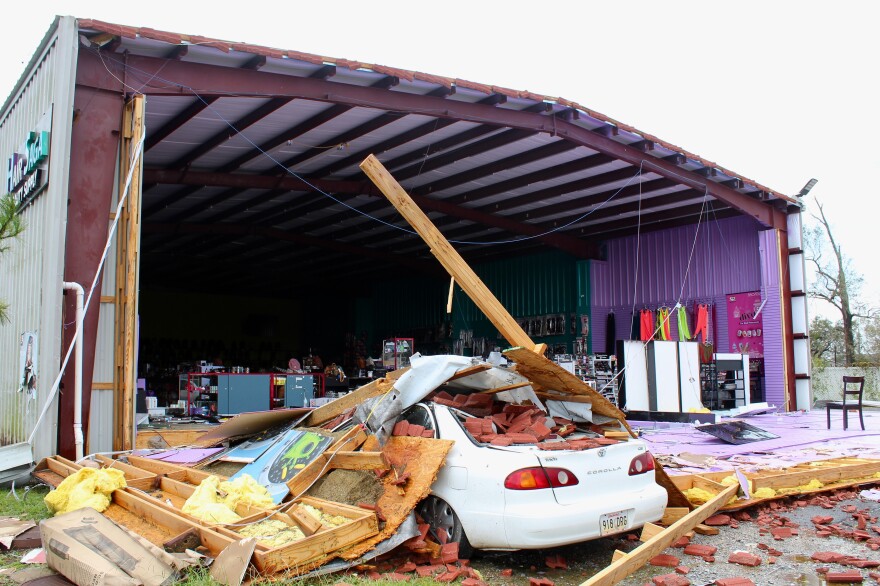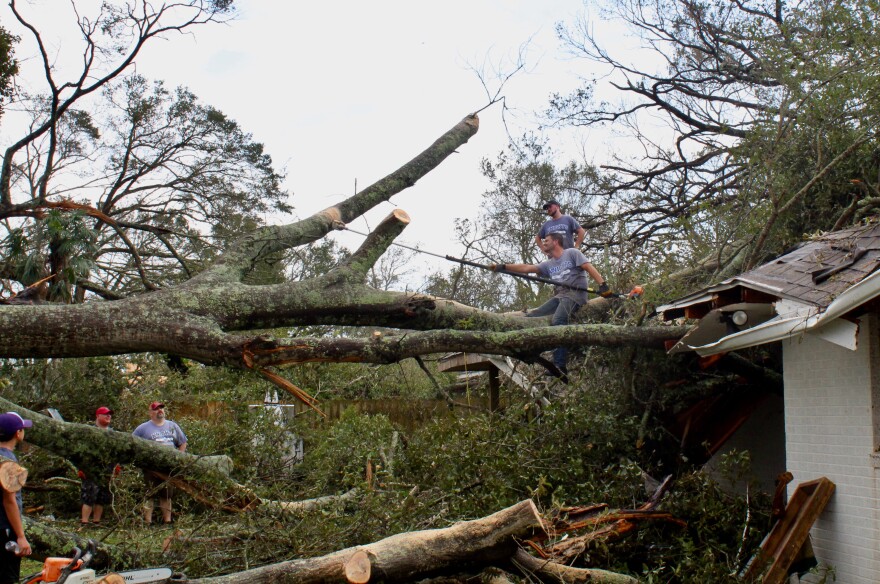The front wall of Hair Saga Beauty Supply in Lake Charles, Louisiana, used to be covered with hundreds of expensive wigs. Now, it’s lying flat in the store’s parking lot, ripped from the building by Hurricane Laura’s 150 mph winds.
Underneath the wall is a white Toyota corolla. It belongs to 20-year-old Abdullah Manea. His family owns and operates the store.
“I lost my mind,” Manea said, describing his reaction when he first saw the damage. “I left and came back. I said it must be something else. When I came back it’s that.”
And the wigs? As far as Manea can tell, they’re gone. Either washed away by storm waters or buried underneath the rubble. Next to the fallen wall lies a single ponytail of dark brown hair.
“It’s a lot of money. It was human hair from this corner all the way to the other corner,” he said gesturing to the wall. He estimated the wigs total more than $70,000 in lost inventory.
Listen: Lake Charles, La., Begins Recovery Process After Hurricane Laura
Laura hit the Texas-Louisiana border early Thursday morning as a Category 4 storm. It caused billions of dollars in damages, primarily in the Lake Charles area where few structures were spared. A day after the storm hit, Interstate 10 was packed with emergency vehicles and utility trucks heading to Lake Charles from the east. At least 15 Louisianans are dead according to the Department of Health.

“The good news is we didn’t have inundation 30 miles inland, as they had predicted, from storm surge,” Edwards said at a press conference. “But that didn’t mean we didn’t have tremendous devastation down there.”
Anticipating the worst, officials begged residents to evacuate and for the most part they did. Now they want to come back, but they're not finding it easy.
The city is without electricity and running water, and could be that way for weeks. Roads are blocked, some with storm debris, while others are flooded out. Residents are anxious to check on their property, their pets, or on friends and family that chose to stay behind.
Not a lot of people are back and if they are, it’s often just for the day. Officials have encouraged residents to stay away, citing the lack of municipal services, severe heat warnings and other dangers.
Edwards said more than 10,000 storm evacuees are staying in hotels statewide with another 4,000 in Texas. With COVID-19 still a major threat, officials have avoided opening large shelters where social distancing can be difficult and the virus is more likely to spread.
A day after the storm hit, 72-year-old Robert Gayle went downtown to survey the damage. He said he’s lived in Lake Charles his entire life, and it’s the worst he’s ever seen.

More than 100,000 homes and businesses are without power in Calcasieu parish, where Lake Charles is located. Utility companies have sent approximately 17,000 employees from 29 states to help restore power. Getting electricity back could take three weeks, Edwards said Monday.
“You basically have to rebuild the entire system to get it back to the neighborhoods,” Gayle said. “And our street is totally impassable with trees down.”
His truck is stuck in his driveway, so he’s been navigating the city by bike. Gayle said he went 15 days without power after Hurricane Rita. He’s expecting at least as long a wait this time around.
After past storms, Gayle said he’s looked to the resiliency of downtown landmarks for comfort — the impossibly tall broadcast tower or the city’s tallest structure, a 22-story office building. Sometimes there would be visible signs of damage, but both persevered.
After Laura, the tower had crumpled and the building was gutted.

Residents are focused on protecting what remains. On Friday, Manea, whose family owns Hair Saga, was staring up at the warehouse-like structure that now looks more like a dollhouse.
“I’m trying to pay these people to at least cover her up with wood. I don’t know what we’re going to do about it,” Manea said. He had called a storm repair company. Employees in neon yellow safety vests were preparing a cost estimate.
His family owns three businesses in Lake Charles. Two — the beauty store and a clothing store — were severely damaged. The third is fine.
“We’re gonna get it running again, but I don’t know how long it will take,” Manea said. He’s more concerned with getting people back to Lake Charles. Not only are they his customers, but they’re his neighbors and his friends.
Lake Charles is home to 80,000 residents, largely working-class. While many are familiar with storm recovery, it doesn’t make the process that much easier. There’s the physical labor — toiling in the hot sun to clear debris and institute temporary repairs — as well as the bureaucratic quagmire.
Residents will need to file insurance claims and apply for government aid. Inspectors surveyed more than 200 damaged homes and issued more than $650,000 in assistance on Sunday alone, according to federal emergency officials.
President Trump approved a major disaster declaration for five of the hardest-hit parishes — Allen, Beauregard, Calcasieu, Cameron and Jefferson Davis — late Friday night. The declaration frees up millions in federal disaster funds, including FEMA aid for those impacted by the storm.
The Piatt family evacuated to Arkansas ahead of Laura, but was back in town last Friday assessing the damage to their home on Bayou Road. There were trees down all over their neighborhood, including on top of their house.

24-year-old Abby Piatt said things looked okay at first, but when they walked around to the backyard they discovered several large oak trees had splintered, the branches piercing their home.
“Mom said, ‘I always wanted a skylight in my kitchen, but not like this,’” Piatt said with a laugh. The family was in good spirits despite the substantial damage.
In the kitchen, tree branches, wires and loose boards hung down from the punctured ceiling, where sunlight pierced into the dim room. Pink insulation was scattered like snow across cracked countertops. Tomatoes sat unharmed on the kitchen counter.
Furniture and belongings were clustered in the front of the house away from the worst of the damage. Piatt said they were afraid the rest of the ceiling might cave in. Chainsaw wielding volunteers were up on the roof working to remove some of the tree’s weight.

“We kind of expected a little bit worse than this, considering we were expecting a 10-foot surge,” said Austin Thorne, Piatt’s brother-in-law. “We’re really counting our blessings there’s no water damage.”
Thorne and his wife live in the same neighborhood. A tree also fell on their house. With a baby on the way, he says he’s trying to make repairs as quickly as possible.
“The nursery was almost done, but now we gotta start all over again,” Thorne said. “I know my wife is nervous, but I’m just trying to get everything set up for her.”
While elected officials are telling residents to stay away for now, Thorne said it’s hard to do that.
“They’re saying look and leave, but I know a lot of folks who are hooking up a window unit with a generator,” Thorne said. “They’re planning on staying, doing whatever they can and just trying to get everybody back on their feet as fast as possible.”






